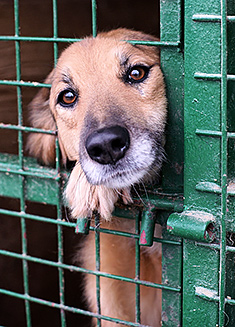Keeping Your Dog Safe in the Great Outdoors
Whether your dog roams loose around your country estate or if you travel the national parks, there are some special safety concerns for your four-legged companion when he or she will spend time communing with Mother Nature. Your number one job as a pet parent is to keep your dog safe, so take a look at the tips below to make sure your dog will remain healthy and well while you both enjoy the great outdoors this summer.
Before you travel
Before you embark on an outdoor adventure with your pooch, make sure you know your dog's overall health status. Certain stages of life present some challenges for dogs, and it's best if you know about these before you plan your trip. For example, if your dog is heading toward his or her senior years and beginning to experience arthritis pain, it might not be the best time to climb Mount Everest.
Very young dogs, although full of energy, are still building bone and shouldn't be exposed to prolonged running or jogging. Once a dog reaches the age of 18 months, his or her bones will be perfectly well-adapted to sprinting after you, but before then, make sure to take frequent breaks to allow your dog's bones time to grow without the punishing impact of continuous frolicking.
Similarly, certain breed types have their own health concerns. Brachycephalic dogs like pugs very often have trouble dealing with the heat. Their short, flat noses simply can't exchange enough air to breathe efficiently during exercise, especially as temperatures rise.
Large breeds are prone to ligament injuries and hip dysplasia, so they must be carefully conditioned over a number of months before attempting strenuous, lengthy hikes or runs. If your vacation will include any type of strenuous exercise, make sure you give your dog time to build up his or her muscles, just as you will condition yours before attempting the trip.
Before leaving home, review your dog's obedience training. If he or she will be wandering the forest or open plains with you, make sure the dog remembers to come when called and to "leave it" when you find him or her playing with unidentified objects found on your adventure. Particularly if you will be hiking in unknown areas, it is imperative that your dog stays close to you. You can train for this by taking your dog on trails near your home, and intentionally taking the fork the dog doesn't take whenever there is a choice. Call your dog and reward him or her richly when the two of you are re-united. Also, make sure your dog will sit-stay when others pass you on the trail. This can keep your dog from getting lost or bitten, and can help other hikers feel safe as they pass you.
Disease Prevention
Make sure your dog is up-to-date on all routine vaccinations required by your jurisdiction, and check with your vet or with the United States Department of State to find out what restrictions apply overseas if you will be traveling abroad with your dog. http://www.state.gov/documents/organization/22230.pdf Countries which do not currently have a problem with rabies or other common diseases may place traveling animals in quarantine.
Even within the United States, Hawaii currently has a 14-day quarantine period for all dogs entering the state because there are no known carriers of rabies in Hawaii and they'd just as soon keep it that way. If you plan a 10-day stay, there would be no point in taking your dog just to have him or her quarantined the whole time.
If you are traveling within the contiguous 48 states, you might want to contact a veterinarian or clinic in the area where you will be staying to find out if there are any diseases indigenous to that area that might require a different vaccine or preventative medicine protocol than your home vet uses. For example, lyme disease is more common in the Northeastern United States than elsewhere, so you might want your dog to have additional flea and tick protection prior to traveling there.
If you will be spending time with your dog in the woods, take the time to find out about any poisonous flora and fauna that thrives in the area where you will be hiking or camping.
Travel plans
Traveling with pets can be a great deal of fun, but it also presents special challenges. Give a little thought to how you will accomplish the "getting there" part of your trip before you leave.
If you're flying, make sure you know your airline's pet policy including the type of crate required and whether or not the animal can fly in the passenger section.
If you're driving, make sure you crate your dog in the car or provide a seatbelt to prevent the dog from jumping out and to reduce the chance of injury during a crash.
Plan extra stops along your route to allow your dog to stretch and use the bathroom.
Check with your hotel to learn about any deposit requirements or pet restrictions.
Stuff you'll need
No matter where you are taking your dog, make sure the animal can be returned to you if lost by providing him or her with easy-to-find identification. ID tags are great, but they can be lost if the dog slips his or her collar. Tattoos are good, but they probably don't include your contact information. Probably the best form of identification is a micro-chip which lists not only your name, address, and phone number, but also any medical issues for which the dog may need treatment before you arrive to recover him or her. No matter which form of identification you choose to use, make sure to include your cell phone number or give Good Samaritans a way to contact you while you are on the road.
Be sure to bring along a water bowl and enough potable water to keep your dog hydrated for whatever adventure you choose. Travel bowls are available at most major pet stores so you don't have to take the heavy ceramic bowl or clunky metal one in your backpack.
If there is any chance you may get stuck out in the wilderness, bring along some sort of nutrition for your dog. Just as you might carry trail mix for yourself, pack along a source of high protein to meet your dog's needs as well.
When you pack your own first aid kit, think about canine first aid as well. You might need a few bandages, some scissors, an ace wrap to hold everything in place, and if you're really adventurous, some string and a needle to field-stitch lacerations until professional help can be found. Make sure you have the name and phone number of an emergency animal clinic with you so you can find immediate care if your dog is injured along the way.
If there is any specific equipment needed for the humans on your trip, chances are your dog will need something similar. For example, if you will be mountain climbing and you are taking fall protection for yourself, find a rig designed for dogs. If you plan on whitewater rafting, your dog needs a life jacket just like your two-legged children do. Planning a bike trip? Buy a reflective leash and collar, and make sure there is a safety release to prevent your dog from knocking you over when a squirrel crosses your path. Hiking during hunting season? Your dog will really appreciate a bright orange vest or collar to distinguish him or her from the wildlife.
Consider the leash you will bring with you. At home, your dog may do great on a retractable leash, but in a forest, you will spend all your time detangling the leash from around the brush and trees. You may be better served with a simple four-foot lead. Even if you normally allow your dog to roam around off-leash, you should bring a lead for those areas that require your dog to be leashed at all times
.Don't forget the poop bags! 'Nuff said.
Staycationing
Even if the only outdoor experience you plan for your dog this summer involves your own backyard, there are a few things to be aware of. The primary problem with dogs in the yard is poisoning. Whether you are introducing new plants to your garden or simply fertilizing your lawn, be aware of the risks these items carry for your canine companions. In addition, make sure you put all of your garden tools away when you're finished. It may be funny on TV, but you won't laugh when your dog steps on the end of a rake and has to go to the emergency clinic for stitches when the other end bonks him or her in the head.
So go ahead, enjoy your summer vacation, but only after you have made accommodations for your pet's safety along the way.
Doggies Den: Latest Articles
 Homemade Thanksgiving Treats for Your Dog
Homemade Thanksgiving Treats for Your Dog
NUTRITION We all want to include our dogs in our holiday celebrations, but hopefully, you're aware that sharing table scraps with your dog isn't always the best idea.
 Keeping Your Dog Safe during the Summer Months
Keeping Your Dog Safe during the Summer Months
HEALTH Summer is coming on fast, so it’s time to plan how you will keep your dog safe and healthy through the lazy, carefree, warm days.
 Vaccination Time Again-Keeping Your Puppy Healthy
Vaccination Time Again-Keeping Your Puppy Healthy
DOG HEALTH So you have your new puppy picked out. There are quite a few shots, treatments and examinations that will keep the newest member of your family healthy.
 Canine Thanksgiving Feast
Canine Thanksgiving Feast
NUTRITION With the wide variety of food at Thanksgiving dinner, chances are you'll want to give your dog something special, too. If you're contemplating what to feed your dog for the holiday, here is a guide to a great Canine Thanksgiving Feast.
 Dog Walking Tips Every Owner Should Know
Dog Walking Tips Every Owner Should Know
DOG FUN Walking your dog is not only crucial to keeping him healthy and happy, it strengthens the bond between your canine friend and his caregiver. There are a lot of obstacles out there. Don’t forget these simple tips to keep your walk fun and safe in the outside world.
 The Benefits of Physiotherapy for your Dog
The Benefits of Physiotherapy for your Dog
HEALTH The same techniques that physiotherapists use to treat a variety of injuries and conditions in humans have been adapted to suit animals with great success. Family pets, show dogs, and working dogs can all benefit greatly from physiotherapy. Dogs whose activities involve a lot of agility are especially susceptible to the types of problems that physiotherapy can address.
 The Decision- Adding a Dog to Your Family
The Decision- Adding a Dog to Your Family
FIRST TIME OWNERSBringing a dog into your family is a decision where many people don’t realize it’s magnitude until after they have the dog. There are a number of things that you need to research before you decide to purchase a dog, and it starts right in your own home.
 Bringing Your Dog Into Your New Baby's Life
Bringing Your Dog Into Your New Baby's Life
HEALTH Many believe that a dog and a new baby cannot happily coexist, so therefore the dog has to go. This is not necessarily the case. A new baby does not mean you have to abandon your dog.

Doggies Den:
Most Popular Articles

Dog Pregnancy Symptoms
HEALTHIf you suspect your dog might be pregnant, check out part one in this series on pregnant dogs, where we cover pregnant dog symptoms.

Dog Birth
HEALTHIn the third article of our dog pregnancy series, we look at the wonderful, but messy, process of bringing newborn puppies into the world.

Indoor Dog Potties
DOG PRODUCTSIt's been a long day at work. You were so busy, you didn't even take time to eat a sandwich, let alone run home to let your dog out. You're on your way home, knowing the poor dog is crossing his or her legs by now, when your car breaks down, delaying you even further. Can't somebody make this easier?

Your Dog’s Digestive System
PHYSIOLOGYEver wonder why your dog eats so fast? Or why he eats gross things? Or why he gets sick to his stomach? Or why his waste stinks so bad? Some of these things are normal, some are not.

Canine Respiratory System
BREATHINGThe basic function of your dog's respiratory system is to bring oxygen in to and remove carbon dioxide from the body. Knowing the symptoms of respiratory diseases can help you help your stay healthy.

Shelter Dog Adoption Tips for Success
ADOPTION Are you intimidated by the prospect of "rescuing" a dog from a shelter? One reason that you may be wary of adopting a dog from a shelter is not knowing how to choose. Adopting a dog from a shelter can be a rewarding process, if you're prepared to do a reasonable amount of research.

Canine Urinary Tract Infections
SYMPTOMS AND TREATMENTDoes your dog seem to be having trouble relieving his or her bladder? Learn how to recognize the signs of urinary tract infections and how to treat them before they spread.

What to do for Dog Diarrhea
SYMPTOMS AND REMEDIESIf you have dogs in your house for any length of time, you have likely experienced at least one bout of dog diarrhea. Beyond the pain in the tuckus involved in cleaning up the mess, you should know what causes diarrhea, and when it's important to see the vet.

What to do for a Dog Bite
DOG BEHAVIOR Getting bitten by a dog can be scary, and you may be tempted to run around in circles for a while, trying to figure out what to do. Here's our guide to help you manage the situation.

Top Ten Tips for Living with a Senior Dog
DOG HEALTH Bringing home a new puppy is so exciting, but it doesn’t take all that long for your exuberant puppy to grow into a senior dog who may have special needs. Here are the doggies.com top ten tips for taking care of your companion who has been with you through so much.
